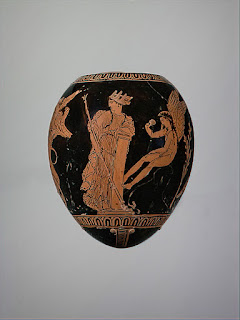In many myths, ranging from Egypt to the Far East, the initial process of creation and birth begins when a cosmic egg. sometimes fertilized by a serpent but more often laid in the primeval sea by a giant bird. From these sacred eggs, the sun (the golden yolk) is hatched leading to the division of earth and sky and the multiplicity of life, natural and supernatural. Eggs are well attested as funerary offerings—real eggs, artistic counterparts in marble and terracotta or diminutive vases of egg shape.
Between approximately 65,000 and 55,000 years ago, African hunter-gatherers scratched on eggshells at Diepkloof Rock Shelter in South Africa. Eggs were found in the Royal Cemetery at Ur dating to 3800 BCE. In archaeological sites of predynastic Egypt (Naqada II period - 3600-3200 BCE) ostrich eggs were found in graves, partially cut and used as containers or placed in graves whole. Many of the eggs were decorated with incised or painted designs which took the form of geometric decoration or drawings of birds and animals. Since then, evidence has been recovered illustrating not only the Egyptians, but also the Phoenicians applied artistic designs to ostrich eggs from the first millennium onwards. Their examples, with painted geometric designs used as cups and bowls, have been found in Carthage, Sardinia, Sicily, the Iberian Peninsula and Ibiza. Even the Greeks, Persians, Etruscans, and Romans decorated their eggs, either real or emulated in terracotta pottery, often with mythological scenes like those on black-figured ceramics.
In Greek mythology, Helen of Troy is said to have come from an egg that had fallen from the moon or born from an egg laid by Leda, queen of Sparta, after she had coupled with Zeus, who had disguised himself as a swan. Such scenes have been found on egg-shaped vessels called "oonoi" in a funerary context.
In the ancient world, ostrich eggs were used as containers for food and liquids such as water or milk, as drinking cups, and as bowls. The ancient Libyans offered ostrich eggs to the Egyptian pharaohs as items of tribute. Babylonian and Assyrian texts record the ostrich egg's medicinal as well as its magical values. Ostrich eggs were also used for religious purposes as symbols of fertility and prosperity. In Egyptian Coptic churches, egg iconography represented resurrection.
In 2020, Isotope analysis of decorated ostrich eggs in the British Museum showed that eggs from the same archaeological site had originated in different places. The studies suggested that, rather than the eggs having been laid by captive birds, almost all had most likely been collected in the wild, a potentially hazardous undertaking.
Read more about them here:
https://ticiaverveer.wordpress.com/2016/03/21/the-worlds-oldest-decorated-eggs/
 |
| Attributed to the Washing Painter, this oon (terracotta egg), depicts an abduction scene that has been interpreted as depicting Paris and Helen, 40-410 BCE, courtesy of the Metropolitan Museum of Art in New York. The shape is particularly pertinent to the subject because Helen was hatched from an egg. |
 |
| An example of a Minoan ostrich egg rhyton, ca. 1600 B.C., decorated with two octopuses in red paint. |
 |
| Punic ostrich egg used as a vessel, open at the top. The decoration, painted in red, is arranged in the form of a frieze composed of palmettes separated by vertical bands with interlaced lines on a white background. Necropolis of Puig des Molins. Height: 14.50 cm; maximum diameter: 12.50 cm. Inv. No. 1923/60/305. National Archaeological Museum of Spain courtesy of Wikimedia Commons contributor Dorieo |
 |
| Pottery imitation ostrich eggs painted with black-figure decorations, Greek, 5th century BCE, Kerameikos Archaeological Museum (Athens), courtesy of Wikimedia Commons contributor Giovanni Dall'Orto. |
 |
| Pottery imitation ostrich eggs painted with black-figure decorations, Greek, 5th century BCE, Kerameikos Archaeological Museum (Athens), courtesy of Wikimedia Commons contributor Giovanni Dall'Orto. |
 |
| Pottery imitation ostrich eggs painted with black-figure decorations, Greek, 5th century BCE, Kerameikos Archaeological Museum (Athens), courtesy of Wikimedia Commons contributor Giovanni Dall'Orto. |
 |
| Ostrich egg decorated with geometric motifs, from the Tomb of the Golden Breastplate at Monterozzi loc. Arcatelle, 650 BCE |
 |
| An ostrich egg decorated with painted red lines. Punic artwork from the Iron Age II, Villaricos necropolis, Andalusia, Spain, courtesy of Wikimedia Commons contributor Luis Garcia (Zaqarbal). |
 |
| Pottery imitation ostrich eggs painted with black-figure decorations, Greek, 5th century BCE, Kerameikos Archaeological Museum (Athens), courtesy of Wikimedia Commons contributor Giovanni Dall'Orto. |
 |
| Ostrich eggs were used as grave goods by the Punic- Phoenicians and Etruscans, symbolizing resurrection and eternal life, as well as providing “food” for the deceased. This Punic-Phoenician ostrich egg was found in the Isis Tomb at the Polledrara Cemetery of Vulci in Italy. It once had a mouthpiece and support to form a vessel. Four sphinxes are painted on the surface. |
 |
| 4,000-year-old Egyptian Ostrich egg decorated with spirals at the Archaeological Museum in Brussels, Belgium courtesy of ticiaverveer.wordpress.com. |
 |
| Attributed to the Washing Painter, this oon (terracotta egg), depicts an abduction scene that has been interpreted as depicting Paris and Helen, 40-410 BCE, courtesy of the Metropolitan Museum of Art in New York. The shape is particularly pertinent to the subject because Helen was hatched from an egg. |
 |
| Attributed to the Washing Painter, this oon (terracotta egg), depicts an abduction scene that has been interpreted as depicting Paris and Helen, 40-410 BCE, courtesy of the Metropolitan Museum of Art in New York. The shape is particularly pertinent to the subject because Helen was hatched from an egg. |
 |
| Punic ostrich egg found in the phoenician necropolis of Puig des Molins. Museum of Puig des Molins in Ibiza (Spain) courtesy of Wikimedia Commons contributor Nanosanchez. |
 |
| An ostrich egg rhyton from Mycenae in Greece. The appliqué dolphins are made of faience. The underpiece attached to the base is made of gold foil over a wooden core. 1600 B.C. E. courtesy of Wikimedia Commons contributor Schuppi |
















Comments
Post a Comment